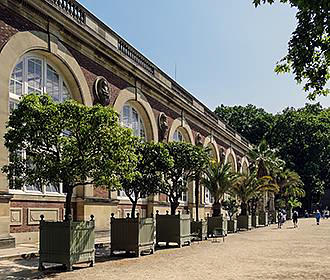L’Orangerie du Jardin du Luxembourg
There has been an orangerie located within the Luxembourg gardens for a few centuries, however, the current building was constructed in the 1830s and now classed as an historical monument, it is still used for the same purpose of nurturing orange trees and palms, although it also holds temporary exhibitions.
About the Orangerie in the Jardin du Luxembourg
Incredibly, some of the oldest and no doubt most beautiful orange trees located within the Jardin du Luxembourg are a sour orange variety that date from around 250 to 300 years ago. These are still nurtured within an Orangerie, which is spelt Orangery in English, although the original building has long since gone and was replaced in 1839 with the building you can see and enjoy today.
Even though the building itself dates from the 1830s, some of the features on the facade, such as busts of artists like Eugene Delacroix, Francois Rude and Antoine Louis Barye were only put in place during the 1880s, which was when the new dedicated building for the Musee du Luxembourg was constructed right next to the Orangerie.
You will find that there are approximately 180 plants and around 60 citrus crates, plus there are date palms and pomegranates, and every year the plants are exposed and positioned within the Jardin du Luxembourg from around May until October.
Yet it is in the September, that all of the plants except for the palms are cut to reduce their volume and retain their shape, in order to help the developing fruit. Plus each plant has to be re-potted at specific intervals due to the encasing starting to rot with the surge of roots, which is a more frequent occurrence for the palms.
When you actually see some of these large palms, which can weigh as much as 4.5 tons, you can probably start to appreciate the effort it takes to care for these and also move them. And this requires the use of a flat bed trailer tractor, which has been equipped with an electric motor since 1996 in order to not only reduce pollution, but noise as well.
So, just this part of the gardens has a whole team working to maintain this part of the history of the Jardin du Luxembourg, which is managed by the French Senate who are located within the Palais du Luxembourg.
However, normally a couple of times a year, when the plants are moved outside into the gardens, temporary exhibitions of paintings, sculptures and photographs are also held within the l’Orangerie du Jardin du Luxembourg.
These are normally held between June and September within the Orangery, which has now been classified as an historical monument in Paris, and it attracts on an average of between 1,000 and 1,500 people per day to the exhibitions from up and coming and local artists.
Visiting l’Orangerie within the Luxembourg Gardens
You will find the Orangerie located within the north western part of the Jardin du Luxembourg right next to the Musee do Luxembourg, which means that the closest entry point is on the Rue de Vaugirard.
Situated in the 6th Arrondissement, when it comes to public transport in Paris, the nearest Metro stations are the Saint-Sulpice stop serving line 4 or the Rennes stop serving line 5, however, for the RER trains, the closest station is the Luxembourg stop serving line B.
Alternatively, the Bus Lines 58, 84 and 89 will get you closest to this entrance near the Orangerie du Jardin du Luxembourg, however, the bus lines 21, 27, 38, 82 and 83 along with the Noctilien Night Bus via Lines N14, N21 and N122 will also get you within walking distance of this tourist attraction and others within the Luxembourg Gardens.
